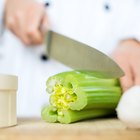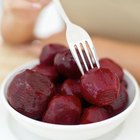
Polka Dot Images/Polka Dot/Getty Images
Although there are numerous ways to prepare cauliflower, blanching preserves its color and texture while preventing the loss of essential vitamins and other nutrients. The process of blanching briefly cooks the vegetable in a pot of boiling water until it just begins to soften, rendering it suitable for either immediate eating or freezing. Health enthusiasts prize this cruciferous vegetable for its nutrition; it is rich in vitamins C and K, and is a natural antioxidant that provides potassium, folate and fiber.
Fill a large stockpot or Dutch oven with water and place on the stovetop. Use one gallon of water for every pound of cauliflower. Bring the water to a rolling boil.
Rinse the cauliflower under cool water and pat dry with a paper towel or clean dishcloth while the water comes to a boil.
Cut away the outer leaves and core with a large chef’s knife. Cut the cauliflower head into the smaller florets -- about 1 inch -- which will blanch more evenly. The smaller florets are also ideal for freezing or can be used as an accompaniment to a zesty dip or sauce.
Fill a handled strainer or wire basket with the cauliflower florets and immerse in the boiling water. Fit the lid to the pot; it’s acceptable if the handle of the basket prevents the lid from fitting perfectly. If you don’t have a wire basket, use a large slotted spoon to remove the florets once they are blanched.
Blanch the cauliflower for about three minutes or until just softened. Ensure the water remains at a full boil and do not overblanch, or the vegetable will become mushy and lose vital nutrients.
Fill a large bowl half full of ice and add cool water while the cauliflower blanches.
Remove the lid from the pot and carefully remove the strainer, allowing the water to drain back into the pot.
Transfer the cauliflower to the ice bath, which will retard the cooking process.
Allow the cauliflower to rest in the ice bath for one to two minutes and drain thoroughly in a strainer.
Related Articles

Steamed or Boiled Cauliflower

How Long Are Tamales Supposed to Cook?

How to Blanch Celery

How to Freeze Romanesco

How to Cook Romanesco Broccoli
How to Preserve Kohlrabi

How to Freeze Fresh Asparagus

How to Perfectly Cook Broccoli
How to Freeze Bok Choy

How to Preserve Rutabagas

How to Blanch Kale for Freezing

How to Eliminate Bitterness in Broccoli

How Long Should You Steam Kale?

How to Freeze Broccoli

How to Blanch Cabbage

How to Boil Beetroot

How to Blanch Collard Greens

How to Blanch Bitter Greens for Italian ...

How Fast Does Cooked Spaghetti Squash ...

How Long Is Steamed Cauliflower Good ...
References
- Vegetarian Cooking for Everyone; Deborah Madison
- University of the District of Columbia: Cauliflower
- Clemson Cooperative Extension: Freezing Fruits and Vegetables
- National Center for Home Food Preservation: Freezing
Resources
Tips
- Select firm, tight heads of cauliflower with bright, green leaves and without any bruises or soft spots.
- After the cauliflower has drained thoroughly from the ice bath, it’s suitable for freezing in plastic freezer bags or containers. Once frozen, the florets should be used within 12 to 18 months.
- Blanching and parboiling are synonymous terms.
Warnings
- Do not overcrowd the pot of water with the cauliflower or it will not cook evenly.
- According to the National Center for Home Food Preservation, research indicates that microwave cooking is not an effective method of blanching and could result in a loss of color and texture.
Writer Bio
Kristie Brown is a publisher, writer and editor. She has contributed to magazines, textbooks and online publications. Brown holds a Bachelor of Arts in English from the University of Texas at Austin.
Photo Credits
Polka Dot Images/Polka Dot/Getty Images